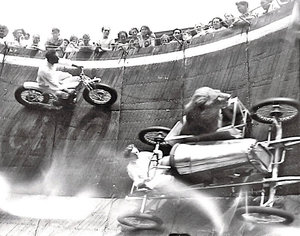Difference between revisions of "Wall of death"
m |
m |
||
| (2 intermediate revisions by the same user not shown) | |||
| Line 1: | Line 1: | ||
| − | + | {{X}} | |
| + | [[Image:Wall.jpg|thumb|right|300px]] | ||
| − | |||
| − | The audience views from the top of the drum, looking down. The bikes start in the middle, at the bottom of the drum, and drive up an initial ramped section until they gain enough velocity to drive horizontal to the floor, defying gravity. | + | The '''Wall-of-Death''' (AKA Motordrome) is a [[carnival]] [[sideshow]] featuring a drum- or barrel-shaped wooden cylinder, ranging from 20 to 36-feet in diameter, in which stunt motorcyclists ride and carry out tricks. Derived directly from US motorcycle boardtrack (motordrome) racing in the early 1900s, the very first carnival motordrome appeared at Coney Island amusement park (New York) in 1911. The following year portable tracks began to appear on traveling carnivals and in 1915, the first "silodromes" with perpendicular walls were seen. These motordromes with perfectly straight walls were soon dubbed the "Wall-of-Death." This carnival attraction became a staple in the US outdoor entertainment industry with the phenomenon reaching its zenith in the 1930s with more than 100 motordromes on traveling shows and in amusement parks. The first known Wall-of-Death in the UK appeared in 1929 at Southend. |
| + | |||
| + | The audience views from the top of the drum, looking down. The bikes start in the middle, at the bottom of the drum, and drive up an initial ramped section until they gain enough velocity to drive horizontal to the floor, defying gravity. This is a famous act in the [[United Kingdom]], and is often seen at fairs. In the 2000s, there are only a few remaining tours of the wall of death; the most notable of which is "The Wall of Death World Tour", created and run by the Fox family. This touring group uses the original [[United States|American]] [[Indian Motorcycles]], which have been used since around the 1920s. For the most of the year, this group is based at Wilburton but ride every year in the Great Dorset Steam Fair. In India, cars are also used. [http://www.flixxy.com/cars-motorcycle-driving-skills.htm] | ||
| + | |||
| + | A similar act called the "'''Globe-of-Death'''" has the riders looping inside a wire mesh sphere rather than a drum. This form of motorcycle entertainment had a separate and distinct evolution from carnival motordromes and derived from bicycle acts or "cycle whirls" in the early 1900s. | ||
==References== | ==References== | ||
Latest revision as of 15:36, 13 June 2009
The Wall-of-Death (AKA Motordrome) is a carnival sideshow featuring a drum- or barrel-shaped wooden cylinder, ranging from 20 to 36-feet in diameter, in which stunt motorcyclists ride and carry out tricks. Derived directly from US motorcycle boardtrack (motordrome) racing in the early 1900s, the very first carnival motordrome appeared at Coney Island amusement park (New York) in 1911. The following year portable tracks began to appear on traveling carnivals and in 1915, the first "silodromes" with perpendicular walls were seen. These motordromes with perfectly straight walls were soon dubbed the "Wall-of-Death." This carnival attraction became a staple in the US outdoor entertainment industry with the phenomenon reaching its zenith in the 1930s with more than 100 motordromes on traveling shows and in amusement parks. The first known Wall-of-Death in the UK appeared in 1929 at Southend.
The audience views from the top of the drum, looking down. The bikes start in the middle, at the bottom of the drum, and drive up an initial ramped section until they gain enough velocity to drive horizontal to the floor, defying gravity. This is a famous act in the United Kingdom, and is often seen at fairs. In the 2000s, there are only a few remaining tours of the wall of death; the most notable of which is "The Wall of Death World Tour", created and run by the Fox family. This touring group uses the original American Indian Motorcycles, which have been used since around the 1920s. For the most of the year, this group is based at Wilburton but ride every year in the Great Dorset Steam Fair. In India, cars are also used. [1]
A similar act called the "Globe-of-Death" has the riders looping inside a wire mesh sphere rather than a drum. This form of motorcycle entertainment had a separate and distinct evolution from carnival motordromes and derived from bicycle acts or "cycle whirls" in the early 1900s.
References
- Ford, Allan, and Corbie, Nick, Riding the Wall of Death, 2006, Tempus Publishing (ISBN 0-7524-3791-7)
